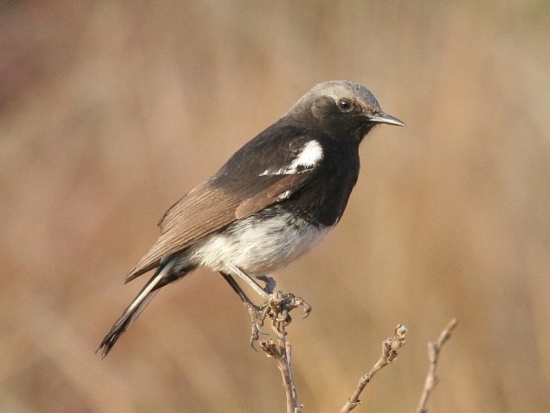| Line 3: | Line 3: | ||
==Identification== | ==Identification== | ||
Photo Taken: Suikerbosrand NR, South Africa | Photo Taken: Suikerbosrand NR, South Africa | ||
| − | |||
| − | |||
| − | |||
| − | |||
| − | |||
Mountain Wheatear is 18-20 cm long, and like other wheatears, it has a distinctive tail pattern, with a white rump and outer tail feathers. Its legs and pointed bill are black. | Mountain Wheatear is 18-20 cm long, and like other wheatears, it has a distinctive tail pattern, with a white rump and outer tail feathers. Its legs and pointed bill are black. | ||
The male is very variable in plumage, although the tail pattern and a white shoulder patch are always present.a white and black bird. The body plumage varies from pale grey to almost black, and it may or may not have a white crown to the head. The female is entirely dark brown apart from the white rump and outer tail. | The male is very variable in plumage, although the tail pattern and a white shoulder patch are always present.a white and black bird. The body plumage varies from pale grey to almost black, and it may or may not have a white crown to the head. The female is entirely dark brown apart from the white rump and outer tail. | ||
| + | ==Distribution== | ||
| + | This non-migratory wheatear is resident in mountainous and rocky habitats in Namibia, Botswana, South Africa and southernmost Angola. | ||
| + | ==Taxonomy== | ||
| + | The Mountain Wheatear or Mountain Chat, Oenanthe monticola, is a small insectivorous passerine bird that was formerly classed as a member of the thrush family Turdidae, but is now more generally considered to be an Old World flycatcher, Muscicapidae. | ||
| + | ==Habitat== | ||
| + | ==Behaviour== | ||
The Mountain Wheatear’s song is a clear melodic whistle interspersed with harsh chatters. It is monogamous and nests on the ground amongst rocks, laying 2-4 white eggs. It eats insects and berries. | The Mountain Wheatear’s song is a clear melodic whistle interspersed with harsh chatters. It is monogamous and nests on the ground amongst rocks, laying 2-4 white eggs. It eats insects and berries. | ||
Revision as of 17:30, 7 June 2007
- Oenanthe monticola
Identification
Photo Taken: Suikerbosrand NR, South Africa Mountain Wheatear is 18-20 cm long, and like other wheatears, it has a distinctive tail pattern, with a white rump and outer tail feathers. Its legs and pointed bill are black.
The male is very variable in plumage, although the tail pattern and a white shoulder patch are always present.a white and black bird. The body plumage varies from pale grey to almost black, and it may or may not have a white crown to the head. The female is entirely dark brown apart from the white rump and outer tail.
Distribution
This non-migratory wheatear is resident in mountainous and rocky habitats in Namibia, Botswana, South Africa and southernmost Angola.
Taxonomy
The Mountain Wheatear or Mountain Chat, Oenanthe monticola, is a small insectivorous passerine bird that was formerly classed as a member of the thrush family Turdidae, but is now more generally considered to be an Old World flycatcher, Muscicapidae.
Habitat
Behaviour
The Mountain Wheatear’s song is a clear melodic whistle interspersed with harsh chatters. It is monogamous and nests on the ground amongst rocks, laying 2-4 white eggs. It eats insects and berries.




